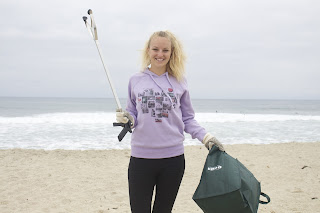Southern California’s wildlife has had to endure some tough times these past few decades. Although most species native to this harsh climate have amazing adaptation skills, the unfortunate events of fires, floods and droughts have been pushing them to their limits. . .or even extinction.
With a head lamp and record chart in hand, I had the unique opportunity to join Bruce Edley, a California State Park’s Environmental Science Intern, to do my first night survey for the elusive, and endangered, Arroyo toad (Anaxyrus californicus). Unfortunately we did not find any A. californicus, but we did find a few common desert species such as the California toad (Bufo boreas halophilus), a Granite Night Lizard (Xantusia henshawi), and many young Pacific Treefrogs (Psuedacris regilla).
 |
| A juvenile Pacific Tree frog (P. regilla) that just underwent metamorphosis Photo credit: Mallory Lindsay |
 |
| Newly transitioned Pacific Tree Frog Photo credit: Mallory Lindsay |
 |
| Granite Night Lizard (X. henshawi) Photo credit: Mallory Lindsay |
 |
| California Toad (B. b. halophilus) Photo credit: Mallory Lindsay |
According to the US Fish and Wildlife Department , “the Arroyo Toad is a relatively small (2-3 inches snout-vent length) toad. Its coloration ranges from olive green or gray to light brown. It can be distinguished from other toads by non-paired, symmetrical dorsal blotches, bicolored parotid glands that are dark posteriorly and light anteriorly as well as a light spot on the sacral humps. A prominent white "v-shaped" stripe crosses the top of the head between the eyes. It lacks a middorsal stripe. The belly is buff-white and often lacks spots. Locomotion is generally in the form of hopping as opposed to walking or taking large jumps.”
 |
| Image of an endangered Arroyo toad (A. californicus) Photo Credit:Rorabaugh |
Unfortunately due to habitat degradation and catastrophic events (fire, flood, drought, etc), this small amphibian is declining in numbers in certain regions of southern California. Their pickiness of breeding sights is also their demise. Females prefer shallow, slow moving water with shallow sloping sandy bank. If any of these conditions are less than perfect, females will not lay eggs, but will wait for better conditions. As a result, there are no prodigy to replenish the lost numbers due to predation, road fatalities and age.
As of late 2014, the US Fish and Wildlife are in the final "comment stages" of reclassifying the Arroyo toad from endangered to threatened. There are many mixed feelings on this subject that are causing quite the controversy between the food providers of this country and the environmentalists. In 1994, a $3.3 million dollar plan was implemented to protect the Arroyo toad and its habitat. This endeavor prevented any land deemed as "Arroyo toad habitat" to be used for mining, agriculture, grazing, etc in order to re-establish the declining amphibian's population. Although seemingly successful for over a decade, the Arroyo toad has been in decline in recent years due to natural disasters in the San Diego area. So what do we do? Do we continue investing more money to save this species. . .or allow the land to be utilized to provide food for the country?
That is a question that each one of us need to ask ourselves. Our actions reflect wildlife in so many ways. To say, "stop eating this animal" or "do not touch this habitat" is easy, but what about those that it effects when that happens. In the US, we are quite spoiled and could easily cut down on many of our daily consumptions; however, in many countries that is not so easy. Many survive ( and provide for their families) completely off of hunting and trapping animals that are becoming endangered due to habitat loss, not overhunting. Do we tell them they just have to figure something else out because the animal they have been hunting for hundreds of years is now at wrist of extinction due to politics and greed?
Just food for thought before one starts judging another's opinion. There are always two sides to an argument. Please do not just trust the loudest voice. Do your research.
**Amphibians are like the “miner’s canaries” of the environment. They are the first to be effected when pollution, invasive species, or some catastrophe enters into an ecosystem. It is crucial to protect these animals and their environment as their conditions foreshadow our possible future. **
Until next time, this is Ms. Mallory inviting you to. . .
Until next time, this is Ms. Mallory inviting you to. . .

























